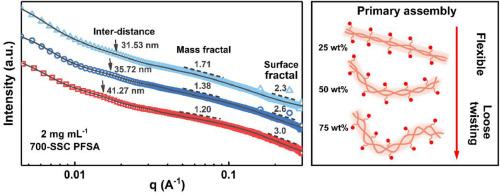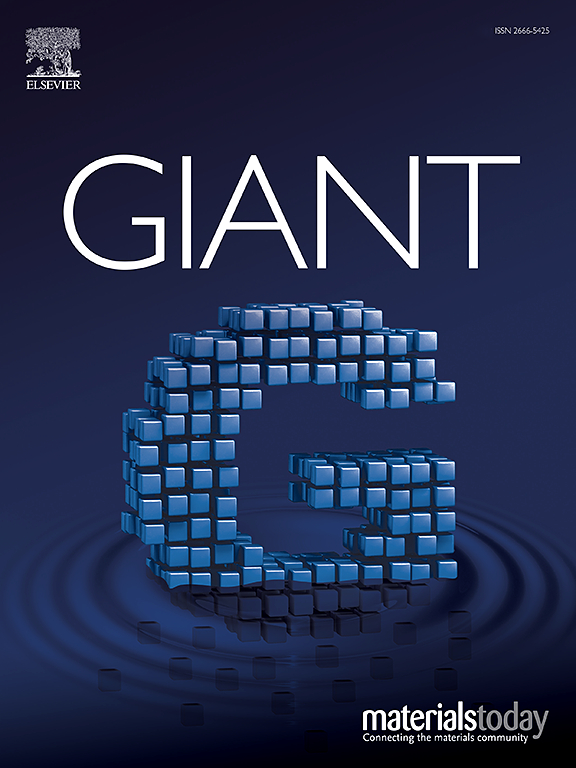Elucidating the solvent-modulated self-assembly nanostructures of high ion exchange capacity short-side-chain perfluorosulfonic acid dispersions
IF 4.9
1区 化学
Q2 CHEMISTRY, MULTIDISCIPLINARY
引用次数: 0
Abstract
The self-assembly behavior of short-side-chain perfluorosulfonic acid (SSC-PFSA) dispersions plays a pivotal role in governing the morphology and performance of proton exchange membranes (PEMs). We explored solvent-modulated structural transitions of SSC-PFSA dispersions using combinatory characterization techniques. It is seen that in high-dielectric environment (25 wt% ethanol), the SSC-PFSA chain adopts rigid rod-like assemblies with locally ordered alignment due to electrostatic repulsion and surface polarization. Lowering the dielectric constant (50 wt% ethanol) induces a semi-flexible configuration with approximately 20 % axial compression, and dispersing heterogeneity is observed due to inter-particle association. Upon reaching 75 wt% ethanol conditions, the rod-like assembly is elongated, loosened, and more disordered. The solvent environment plays an important role in determining the dispersion heterogeneity. More ethanol content lowers the dielectric constant, which reduces acidic dissociation and leads to localized assembly association. This work elucidates a fundamental understanding of the dynamic interplay between backbone solubility and electrostatic interactions in governing the PFSA assembly under different solvent environment. These detailed multi-length-scale nanostructures are key in determining the morphology and performance of PEM, which needs to clearly investigated before PEM fabrication.

高离子交换容量短侧链全氟磺酸分散体的溶剂调制自组装纳米结构研究
短侧链全氟磺酸(SSC-PFSA)分散体的自组装行为对质子交换膜(PEMs)的形态和性能起着关键作用。我们利用组合表征技术探索了SSC-PFSA分散体的溶剂调制结构转变。可见,在高介电环境(25%乙醇)下,由于静电斥力和表面极化,SSC-PFSA链采用刚性棒状组件,具有局部有序排列。降低介电常数(50 wt%乙醇)可产生约20%轴向压缩的半柔性结构,并且由于颗粒间关联而分散非均质性。在达到75%乙醇条件下,棒状组装被拉长,松动,更混乱。溶剂环境对分散不均一性有重要影响。更多的乙醇含量降低介电常数,这减少了酸性解离和导致局部组装联想。这项工作阐明了在不同溶剂环境下控制PFSA组装的主链溶解度和静电相互作用之间的动态相互作用的基本理解。这些详细的多长度尺度纳米结构是决定PEM形态和性能的关键,需要在PEM制造之前进行清楚的研究。
本文章由计算机程序翻译,如有差异,请以英文原文为准。
求助全文
约1分钟内获得全文
求助全文
来源期刊

GIANT
Multiple-
CiteScore
8.50
自引率
8.60%
发文量
46
审稿时长
42 days
期刊介绍:
Giant is an interdisciplinary title focusing on fundamental and applied macromolecular science spanning all chemistry, physics, biology, and materials aspects of the field in the broadest sense. Key areas covered include macromolecular chemistry, supramolecular assembly, multiscale and multifunctional materials, organic-inorganic hybrid materials, biophysics, biomimetics and surface science. Core topics range from developments in synthesis, characterisation and assembly towards creating uniformly sized precision macromolecules with tailored properties, to the design and assembly of nanostructured materials in multiple dimensions, and further to the study of smart or living designer materials with tuneable multiscale properties.
 求助内容:
求助内容: 应助结果提醒方式:
应助结果提醒方式:


